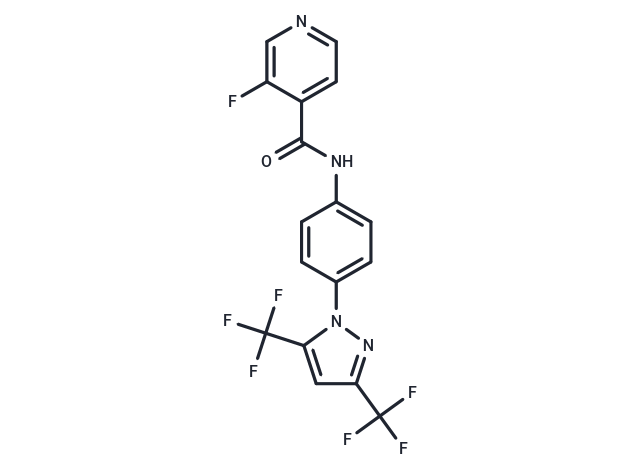Shopping Cart
- Remove All
 Your shopping cart is currently empty
Your shopping cart is currently empty

Pyr6 (N-[4-[3,5-Bis(trifluoromethyl)-1H-pyrazol-1-yl]phenyl]-3-fluoro-4-pyridinecarboxamide) is a selective TRPC3 inhibitor with IC50 of 0.49 uM(Ca2+ influx inhibition in thapsigargin depleted native RBL-2H3 cells).Pyr6 is an inhibitor of Ca2+ entry, which displays higher potency to inhibit Ca2+ entry mediated by CRAC channel than by TRPC3.

| Pack Size | Price | Availability | Quantity |
|---|---|---|---|
| 5 mg | $31 | In Stock | |
| 10 mg | $52 | In Stock | |
| 25 mg | $86 | In Stock | |
| 50 mg | $128 | In Stock | |
| 1 mL x 10 mM (in DMSO) | $35 | In Stock |
| Description | Pyr6 (N-[4-[3,5-Bis(trifluoromethyl)-1H-pyrazol-1-yl]phenyl]-3-fluoro-4-pyridinecarboxamide) is a selective TRPC3 inhibitor with IC50 of 0.49 uM(Ca2+ influx inhibition in thapsigargin depleted native RBL-2H3 cells).Pyr6 is an inhibitor of Ca2+ entry, which displays higher potency to inhibit Ca2+ entry mediated by CRAC channel than by TRPC3. |
| Targets&IC50 | TRPC3:0.49 uM |
| In vitro | Pyr3 is selective inhibitor of TRPC3, inhibited Orai1- and TRPC3-mediated Ca(2+) entry and currents as well as mast cell activation with similar potency.?By contrast, Pyr6 exhibited a 37-fold higher potency to inhibit Orai1-mediated Ca(2+) entry as compared with TRPC3-mediated Ca(2+) entry and potently suppressed mast cell activation. |
| Alias | N-[4-[3,5-Bis(trifluoromethyl)-1H-pyrazol-1-yl]phenyl]-3-fluoro-4-pyridinecarboxamide |
| Molecular Weight | 418.27 |
| Formula | C17H9F7N4O |
| Cas No. | 245747-08-4 |
| Smiles | Fc1cnccc1C(=O)Nc1ccc(cc1)-n1nc(cc1C(F)(F)F)C(F)(F)F |
| Relative Density. | 1.52 g/cm3 (Predicted) |
| Storage | Powder: -20°C for 3 years | In solvent: -80°C for 1 year | Shipping with blue ice. | |||||||||||||||||||||||||||||||||||
| Solubility Information | DMSO: 95 mg/mL (227.13 mM), Sonication is recommended. | |||||||||||||||||||||||||||||||||||
Solution Preparation Table | ||||||||||||||||||||||||||||||||||||
DMSO
| ||||||||||||||||||||||||||||||||||||

Copyright © 2015-2025 TargetMol Chemicals Inc. All Rights Reserved.